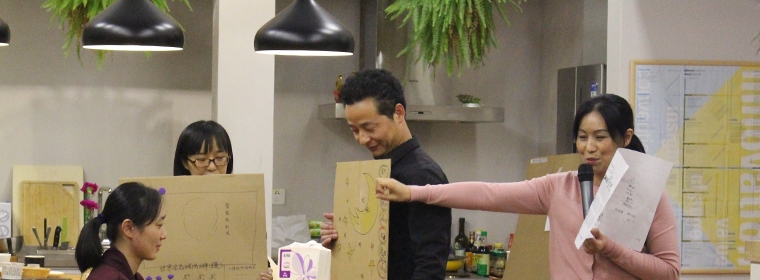- English
- 中文
Service Prototyping Workshop & Training Jan. 30th

The Power of Service Prototyping for Business: 2 Day Workshop ( Jan 30th-31th )
CBi China Bridge has invited Hellon, a company well known as the best firms for Service and Design Prototyping from around the world... this is not joke. They kick ass. CBi China Bridge is teaming up with Markus Hohl from Hellon to provide a 2 days Service Prototyping Workshop. The goal of the workshop is to upgrade your skills and capabilities for practical service prototyping for experiences across key industries such as Retail, Travel & Transportation, Finance, Healthcare, Entertainment.
Workshop Agenda
Day 1: The value, method and case application of service prototype
I. Theory Introduction
1) Introduce the "End to End" thinking of Service Design
2) Why is Service Prototyping an essential skill for an innovative organization?
3) Introduce the method of multi service prototyping
II. Case Study Review
- Finland master over 10 years of actual front-line case experience sharing—How to use the service prototype to trigger traffic, healthcare, financial, retail, entertainment and other industry changes?
- Case: Helsinki Airport, Tesco (Le Gou), Bank of Ireland, etc.
III. Practical Rehearsal
1) According to the provided service prototype props, practice different types of service prototyping methods on site.
2) Practice using sketches and storyboards to express your ideas and get feedback
3) Around the interesting mystery proposition, team members work together to create, to practice and promote learning
IV. Interactive Teaching
1) Students may ask questions on the course of the day freely, and the tutor will answer questions on the spot.
2) Instructors, according to the students’ learning level, always control the way and step of class to help students quickly understand the service prototype in different scenarios through coaching guide.
Day 2: Testing, evaluation and iteration of service prototype
I. Theory deepening
1) Introduce further service prototyping methods, such as role-playing
2) How do you make your service prototype create immersive user experiences?
3) How to gain insight into real user requirements from service prototype testing?
II. Practical Rehearsal
1) Practice, role playing, and other forms of service prototyping
2) Work with other team members to test service prototypes
3) Service prototype iteration based on feedback
III. Interactive Teaching
1) Students and Finland masters talk face to face on the use of service prototypes in their daily work
2) Instructors will camouflage themselves in actual combat phase moderately, giving students greater autonomy and stimulating their creativity
3) Issue Workshop Certificate
What is a Service Prototype!
It is a tool for testing the services by observing the interaction of the user with a prototype of the service put in the space, the situation and the condition where the service will actually exist.
In recent years, financial, medical, public transportation, those three industries are undergoing great change! Banking subversion, sharing hospital and sharing cars are turning out in the battle. The original common characteristics of these industries are: heavy assets, heavy investment, transformation difficulty, long process, extremely wide influence once with bad experience.
While the "service prototype", with its less investment, short time, fast trial and error iteration, effective risk- avoiding, etc., gently pry up the three mountains.

↑ The medical industry: building a new pharmacy service booth with cardboard

↑ The financial industry: the creation of a new prototype of banking services, including physical, spatial, social, digital and other contacts
The above service prototype case counters many people's misunderstanding: "Service is too abstract to make a prototype as a product". With the condition of limited time, funds and technology, and other constraints, realizing to make all kinds of concepts into systematic user experience, brand strategy, and commercial advantage - this is a new field with a great investment value.
The service prototype can help companies create high value-added products and services within 1 month, 1 week, 1 day, or even 1 hour, increasing competitiveness and business value.

Here is a Case Study from to get you excited!

Helsinki Airport in Finland hopes to become the preferred transit airport for Asian travelers in northern Europe. The airport management has collected more than 200 recommendations to optimize airport services from passengers and staff. Then comes the question:
So many concepts, how do you choose?
How much time, manpower and budget does it take?
What if you spend a lot of money for a new service but the passengers are not satisfied with the result of the implementation?
For this, they were at a loss to proceed next action.
As the saying goes " We have professionals in charge of different aspects. ", so they go to an insider, cooperating to kick off the project “Travellab”.

The project revealed 12 million euros of potential cost savings a year for Helsinki Airport, and received attention from more than 80 English language publications worldwide; It attracted 5 million +users on twitter and the number of international passengers increased by 3% during that period. It also won two awards: Finland's annual best design award and the SDN New York global service design award.
It took only 75 days to do so. The first 200 recommendations were screened into 12 new service prototypes for testing and evaluating. 900 passengers are involved in the design and improvement of the service experience.

Finally, the airport management has got a new proven service list with priority, as well as a reusable digital ranking tool used to understand which investment return rate is the highest, providing a key basis for the strategic decision for the airport in the future.
Guest Mentors

Markus Hohl
Design Director, MD Hellon London
Markus has 20 years international experience in design and design strategy, in telecoms, transportation and retail. He teaches at the Royal College of Art, Warwick Business School and Design Council in the UK.

Cathy
Head of SDN Shanghai Chapter,
Chairperson of CBi China Bridge and co-founder of Successful Design.Org.
She is a serial entrepreneur, challenger of innovation boundaries, as well as a promoter of Service Design in China. She has over 20 years experience in design industry. She dedicates herself in utilising design to help China local companies go through strategic transformation, make breakthrough in service innovation and create business value for the company.
Organizers

Hellon’s human-centered approach helps organizations build holistic customer journeys, from end to end and across multiple channels. They help organizations ideate, design and implement innovative services based on true customer insight. Clients: Helsinki Airport,Bank of Ireland,YTA,Saarioinen, etc.

CBi China Bridge is the founding company of Shanghai Chapter of the Service Design Network. Noted as "Mckinsey in Design Industry" for more than a decade, leading organisations and brands have come to CBI China Bridge when they need to “Innovate & Design Their Next”.
Collaboratively, CBi China Bridge works together with their clients to discover opportunities for growth, define actionable strategies and design innovative solutions that deliver holistic experiences in China for China.
Learn More: http://cbichinabridge.com
We’ve seen first hand how quickly Chinese companies in the manufacturing sector have moved to Product Servitization (adding services to product). In 2007, according to a study conducted by University of Cambridge, less than 1% of Chinese manufacturing firms had servitized, but by 2011 over 19% offered services along with their products. These companies are offering services such as:
Financial Services – helping customers finance expensive equipment, allowing more customers to afford their products and gain value from it.
Installation and implementation - for complex products, assuring that customers can generate value from the product soon and as effectively as possible.
Leasing, maintenance and support – removing the headache of worrying about maintaining the purchased equipment and lowering the cost-of-entry.
Based on our experience the amount of companies that offered services along with their products is even higher now, and acts as a clear indication that these companies are moving up in the value chain. This shift creates higher value for both companies and their customers. It also proves that the market is becoming competitive, forcing companies to innovate faster, targeting the right areas, than their competitors. Focusing on creating greater experience for the customers will continue to play a large role in differentiation and companies that don’t have strong internal (or outsourced) innovation engines will find themselves falling further and further behind.
Have you thought how you can improve the experience your customers have with your product, service, or brand?

